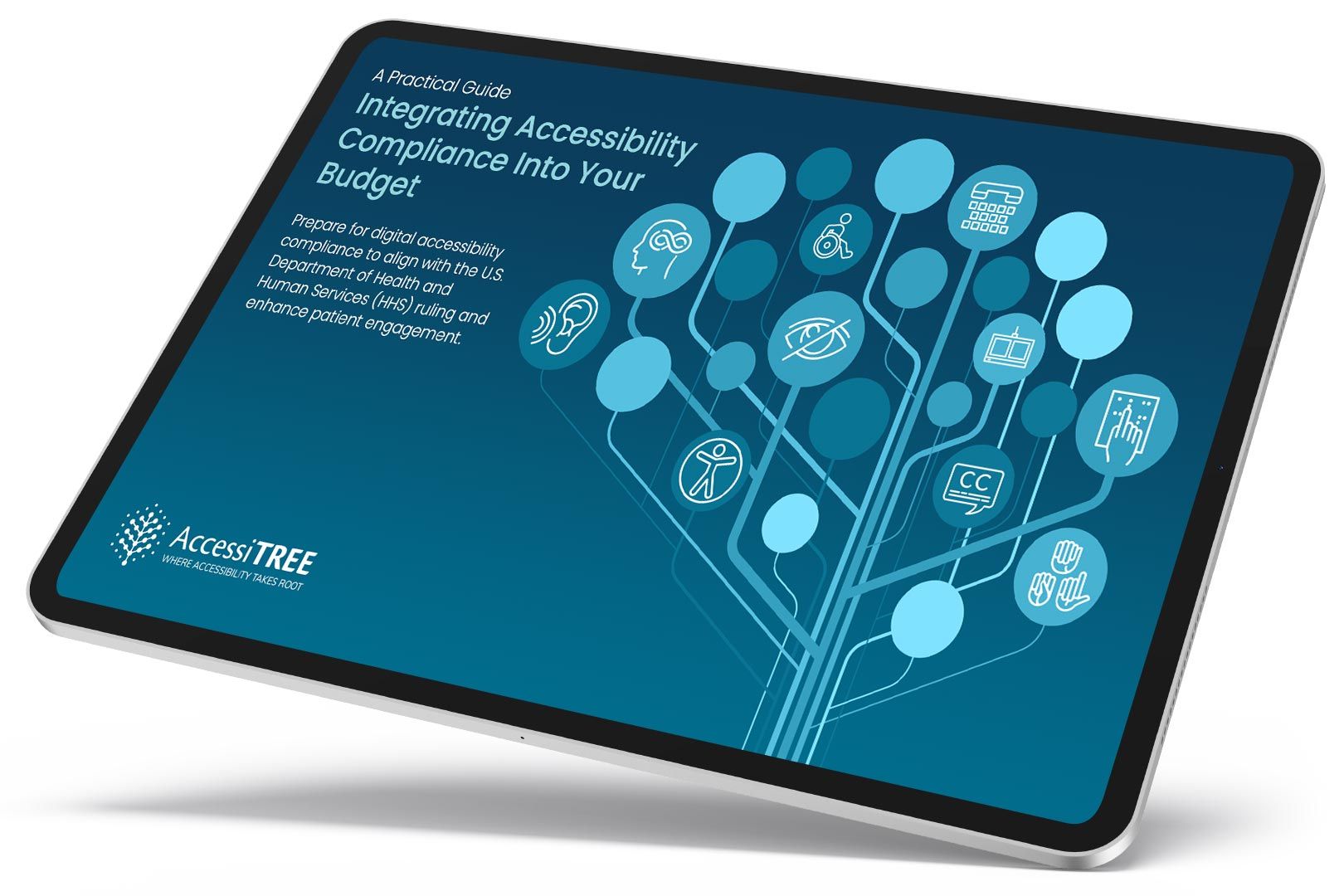
Why Your Mental Health Website is a Clinical Tool, Not Just a Brochure
Your website is the new front door to care. For an individual in a state of distress, it is often the very first point of contact with your organization, a digital space that can either welcome them into a place of healing or become another frustrating barrier on their path to wellness.
In mental healthcare, a website is not merely a marketing channel or an informational repository; it is a clinical environment. The design, structure, and accessibility of this digital space are direct reflections of your organization’s commitment to its mission. They have a tangible impact on user well-being and, ultimately, on your bottom line.
This article explores why digital accessibility is no longer a technical nice-to-have, but a core strategic imperative for every mental healthcare leader. We will unpack the compelling return on investment (ROI) of creating a truly inclusive digital experience and provide a clear-eyed view of the risks of inaction.
The High-Stakes Digital First Impression
Unlike users of e-commerce or entertainment platforms, individuals approaching a mental health website are often in a state of heightened anxiety or acute crisis. Their cognitive capacity may be limited, and their tolerance for friction is exceptionally low.
In this context, a poorly designed site, one that is cluttered, confusing to navigate, or slow to load, can actively compound a user’s stress. This creates a profoundly negative emotional impact before any therapeutic interaction has even begun, eroding trust and creating the impression that your organization is disorganized or uncaring. For someone already ambivalent about seeking help, this can be the final deterrent, causing them to abandon their search for care altogether.
The Critical Link: Disability, Mental Health, and Digital Exclusion
A foundational understanding for any provider must be the profound link between disability and mental health. Individuals with disabilities are at a significantly higher risk of experiencing mental health conditions, not because of the disability itself, but as a direct result of navigating a world filled with societal and environmental barriers.
An inaccessible website is a digital manifestation of the very exclusion that contributes to these mental health challenges. It sends a harmful message that people with disabilities “don’t belong,” replicating the exact form of systemic harm that contributes to their suffering. This elevates the mandate for digital accessibility from a technical best practice to a matter of clinical ethics and mission integrity.
The ROI: A Business Case for Leaders
Investing in an expert-led accessibility and information architecture strategy delivers a powerful, multi-faceted return.
1. Mitigating Escalating Legal Risk
Digital accessibility is a legal requirement. ADA-based website accessibility lawsuits are surging, with thousands of federal cases filed annually. The legal landscape is also hardening:
- The HHS Final Rule (May 2024): The Department of Health and Human Services now explicitly requires web and mobile app accessibility (per WCAG 2.1 AA standards) for any organization receiving federal funds, including Medicare and Medicaid.
- State-Level Legislation: States like Colorado (HB 21-1110) are codifying digital accessibility into anti-discrimination law, signaling a clear legislative trend.
Proactive remediation is a fraction of the cost of a lawsuit, where settlements average $5,000-$100,000 before uncapped legal fees.
2. Expanding Your Reach to an Underserved Market
Viewing accessibility solely through the lens of risk overlooks a vast and loyal market. The disability community is one of the largest and fastest-growing market segments in the world.
- In the U.S. alone, the annual disposable income for adults with disabilities is up to $1.3 trillion.
- Globally, this market commands $1.9 trillion in annual disposable income, anchoring an economic ecosystem worth over $18 trillion when friends and family are included.
An accessible website is a direct invitation to this historically ignored consumer base, allowing you to capture market share that competitors cannot reach.
3. Driving Operational Efficiency
A well-architected and accessible website streamlines operations and reduces internal costs.
- The SEO Dividend: Many core accessibility practices—proper heading structure, descriptive alt text, video transcripts—are also best practices for Search Engine Optimization (SEO), leading to higher organic search rankings and reduced spending on paid advertising.
- Reduced Support Costs: An intuitive user experience generates fewer confused and frustrated users, directly lowering the volume of support calls and freeing up administrative staff.
4. Building Unshakeable Brand Trust
In an increasingly conscious market, brand trust is a priceless asset. Prioritizing web accessibility is a tangible demonstration of your organization’s commitment to Corporate Social Responsibility (CSR), equity, and inclusion. It is a clear signal that you “walk the walk” on your stated values, building a positive reputation that enhances customer loyalty and helps attract top talent.
The “Quick Fix” Trap: Why Automation and Overlays Fail
In the quest for a simple solution, many organizations turn to automated tools and third-party “accessibility overlays.” This is a high-risk strategy that creates a false sense of security.
The Limits of Automation
Automated scanning tools are dangerously limited. Independent analyses consistently show they can only detect, at best, 20-40% of all potential accessibility barriers. They cannot assess context or user experience. An automated tool can see if an image has alt text, but it can’t tell if that text is meaningful. It can’t determine if the navigation order is logical for a screen reader user. Relying on automation alone leaves you legally exposed and your users excluded.
The False Promise of Accessibility Overlays
Accessibility overlays—third-party scripts that promise to automatically fix accessibility issues—are overwhelmingly rejected by accessibility experts, advocates, and legal professionals.
- They Don’t Fix the Core Code: Overlays apply a superficial layer but do not remediate the underlying code where the real barriers exist.
- They Interfere with Assistive Technology: Overlays frequently conflict with the highly customized screen readers and tools that users with disabilities rely on, often making a website less usable.
- They Don’t Prevent Lawsuits: Hundreds of companies using overlays have been successfully sued. The presence of an overlay can even be used as evidence that an organization was aware of its obligations but chose an inadequate solution.
Relying on an overlay is like putting a wheelchair ramp sticker on a staircase. It signals an intention but provides no actual access, creating more frustration while leaving the fundamental barrier in place.
The Path Forward: From Digital Presence to Digital Empathy
Achieving genuine accessibility requires an expert-led, human-centric approach. It begins with a commitment to thoughtful Information Architecture (IA)—structuring your digital space to be a calming, intuitive sanctuary that reduces cognitive load. It is realized through a hybrid strategy that combines the efficiency of automated scans with the nuance and accuracy of expert-led manual audits, where professionals use the same assistive technologies as your users to ensure a truly usable experience.
The goal is not simply to pass a scan; it is to create a supportive and empowering experience for every individual who arrives at your digital front door. This is the moment to move beyond a simple digital presence and embrace a practice of true digital empathy.
ROI Snapshot
A data-driven case for expert-led accessibility in mental healthcare, transforming risk into opportunity and leadership.
The Human Imperative: A High-Stakes Digital Front Door
A mental health website is a clinical environment. For users in distress, a confusing or inaccessible site can heighten anxiety and become a barrier to care.
The Digital Divide is a Clinical Concern
A significant portion of individuals with severe mental illness lack the digital skills required to navigate complex websites. Cognitive symptoms from anxiety and depression can impair concentration and memory, making a clear and accessible experience a clinical necessity.
An inaccessible website risks replicating exclusion and causing digital iatrogenic harm.
The Legal Mandate: A Non-Negotiable Requirement
Digital accessibility is not optional. Lawsuits and explicit regulations have solidified WCAG 2.1 AA as the required standard of care.
Litigation is Surging
Federal lawsuits targeting inaccessible websites continue to grow, with healthcare a primary target. Non-compliance exposes organizations to financial penalties, uncapped legal fees, and reputational damage.
- HHS Final Rule (2024): mandates WCAG 2.1 AA for recipients of federal funds.
- State laws (e.g., CO HB 21-1110): define digital accessibility as a civil right and non-compliance as discrimination.
The Four Pillars of ROI
1. Risk Mitigation
Proactive investment costs less than reactive litigation.
2. Market Expansion
Engage a large, loyal, underserved segment.
Annual disposable income of the U.S. disability market
An accessible digital front door is a direct invitation to this economic force.
3. Operational Efficiency
Accessibility fundamentals align with business optimization.
Drives organic traffic
Reduces support calls
Reduces ad spend
Information architecture improvements can reduce administrative expenses significantly.
4. Brand Equity
Build trust and differentiate as a leader in digital health equity.
The Expertise Gap: Why Automation Fails
Automated scanners create a false sense of security and leave organizations exposed while users remain excluded.
Automation Cannot See Context
- Cannot assess whether navigation is logical.
- Cannot judge whether image descriptions are meaningful.
- Misses barriers in complex forms and widgets.
Only expert-led manual audits using assistive technology can verify true usability and legal conformance.
The Overlay Illusion: A Deceptive Facade
“Quick fix” overlay widgets promise instant compliance but fail to address core issues and often make sites less accessible.
The Promise
- Instant WCAG compliance
- Automated AI-powered fixes
- Protection from lawsuits
The Reality
- Does not fix underlying source code.
- Conflicts with users’ assistive tech.
- Does not prevent successful litigation.

A practical guide for healthcare leaders navigating WCAG compliance.